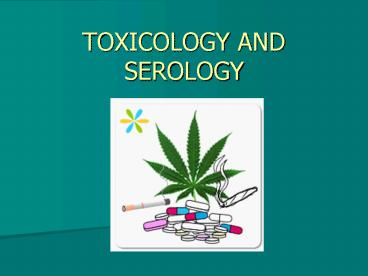TOXICOLOGY AND SEROLOGY - PowerPoint PPT Presentation
1 / 13
Title:
TOXICOLOGY AND SEROLOGY
Description:
TOXICOLOGY AND SEROLOGY. I. TERMS. toxicology- in forensics it is the study of ... serology- the study of blood, blood testing, and bloodstain examination ... – PowerPoint PPT presentation
Number of Views:190
Avg rating:3.0/5.0
Title: TOXICOLOGY AND SEROLOGY
1
TOXICOLOGY AND SEROLOGY
2
I. TERMS
toxicology- in forensics it is the study of
toxins and drugs in the body serology- the study
of blood, blood testing, and bloodstain
examination over the counter drugs- legal
medicines that can be bought without a
prescription prescription medicine- medicines
that require a prescription in order to get
legally illegal or illicit drugs- drugs that are
gotten though illegal means, either because the
drug itself is illegal or because the drug was
not prescribed to the person taking it.
3
heavy metals- metals and metal compounds that
negatively affect people's health EX arsenic,
beryllium, cadmium, nickel, mercury, iron,
magnesium bioaccumulation- build up of toxins
in the food chain, especially pesticides and
heavy metals ecological effects effects of
toxins on ecosystems
Heavy metals
4
carcinogenicity- measure of ability to cause
cancer dose-response response of the body to
varying doses of a drug, toxin etc epidemiology-
the study of the distribution disease in human
populations and the application of this study to
control health problems risk assessment the
process of quantifying the probability of a
harmful effect to individuals or populations from
certain human activities
5
II. SOME TOXICOLOGY FACTS
- A toxin is any material exerting a life
threatening effect upon a living organism. - Toxic materials exist in many forms (gaseous,
liquid, solid, animal, mineral, and vegetable),
and may be ingested, inhaled, or absorbed through
the skin. - Poisons are a subgroup of toxins.
- Poisons generally enter the body in a single
massive dose, or accumulate to a massive dose
over time. - Toxins work in minute quantities or low levels,
requiring sensitive analytical instruments for
detection.
6
III. CLASSIFICAITON OF SOME COMMONLY MISUSED DRUGS
- Depressants
- Narcotics
- Stimulants
- Hallucinogens
7
- also water or oxygen can be toxic
Death in Frat's Hazing Ritual Shakes a SUNY
Campus By LISA W. FODERARO PLATTSBURGH, N.Y.,
Sept. 10, 2003 On a raw, overcast day last
March, Walter Dean Jennings, a freshman at the
State University of New York here, fell
unconscious. By midnight, he was dead. The cause,
according to a medical examiner, was
hyponatremia, a condition in which sodium in the
blood drops to dangerous levels.
8
IV. WHOS ON CHARGE OF DRUGS? Local state, and
federal levels Bureau of Alcohol, Tobacco,
Firearms and Explosives (ATF) Controlled
Substances Act enacted in 1970 by Drug
Enforcement Administration (DEA), places drugs
into 5 schedules Schedule I is reserved for
the most dangerous drugs that have no recognized
medical use, Schedule V is the classification
used for the least dangerous drugs.
9
V. TECHNIQUES FOR IDENTIFICATION OF DRUGS Can
use hair, nails, skin, bones, urine, blood,
breath,
10
SCREENING TESTS Physical tests -- boiling point,
melting point, density, and refractive
index Crystal tests -- treatment with a chemical
reagent to produce crystals Chemical spot tests
-- treatment with a chemical reagent to produce
color changes Chromatography (thin-layer or gas)
-- used to separate components of a mixture
11
CONFIRMATION TESTS Mass spectrometry -- this is
a combination of gas chromatography/mass
spectrometry which is generally accepted as the
confirmation test of choice. Each toxin has a
known mass spectra, or "fingerprint", which is
absolute proof of its presence at the chemical
level
12
VI. TOXICOLOGY OF ALCOHOL IN THE BODY What does
alcohol do to the body? What field tests are
there for alcohol?
13
VII. WHY DO WE TEST?
Can assess whether someone was under the
influence of drugs that impaired their
thinking. Can assess whether someone was
purposely or accidentally poisoned

